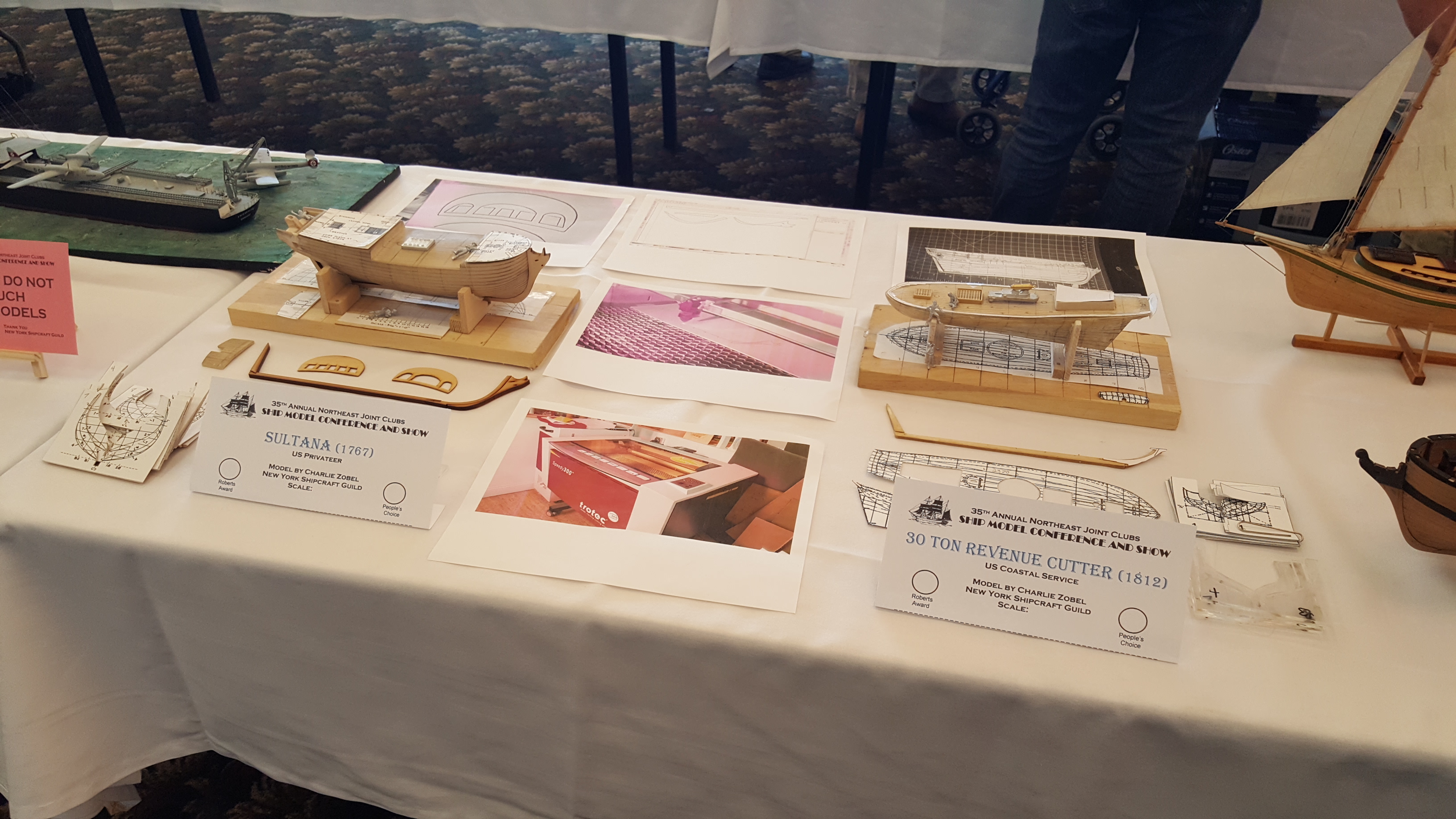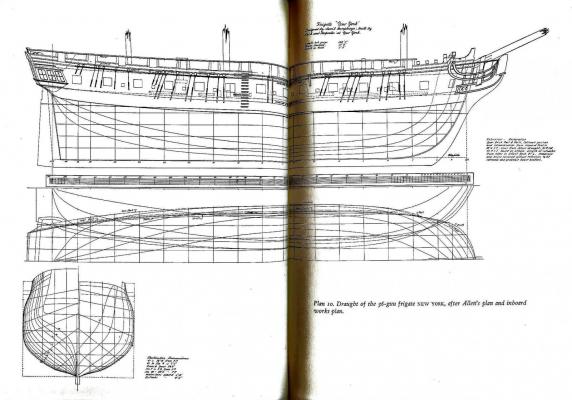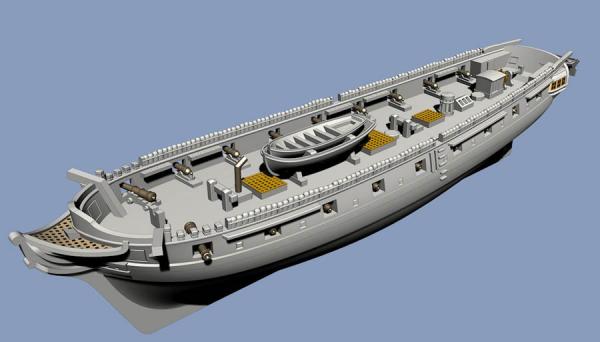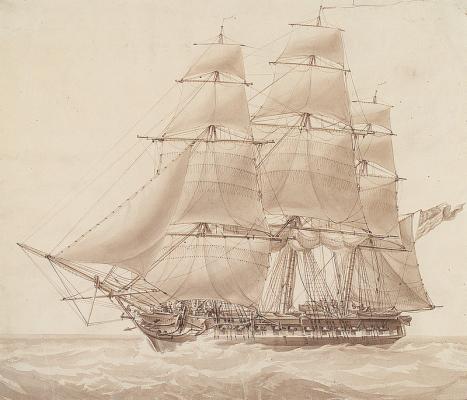-
Posts
969 -
Joined
-
Last visited
Content Type
Profiles
Forums
Gallery
Events
Everything posted by CharlieZardoz
-

The subsciption frigate New York and other details
CharlieZardoz replied to CharlieZardoz's topic in Nautical/Naval History
Its nice to know that descriptions of the Adams detailing survives despite the loss of the plans. If a reconstruction of her ever came to pass (sir Armstrong Im talking to you it could be decorated with a fair deal of accuracy. Up to now most depections of these ships through models Essex or President dont show much carvings so I assume that many of them were removed by 1812 or that they were just not added to the models. One thing I do find interesting is that many of these ships had their stern windows reduced from 6 to 5 (not including the false windows which seemed to eventually be covered up). Essex went through such an alteration as did Constitution most likely. I will assume New York had only 5 windows and probably the stern looked very much like these images im about to post.- 51 replies
-
- frigate
- subscription
-
(and 1 more)
Tagged with:
-

The subsciption frigate New York and other details
CharlieZardoz replied to CharlieZardoz's topic in Nautical/Naval History
And I took this out of Chapelle's book, sorry for the annoying crease but shows pretty much what we are working with. A very handsome frigate which to my eyes looks a bit similar to the Chesapeake. I am curious as to who made her carvings, did the designers work on any other ships one could use as reference and if the ship ever received any significant upgrades before she burned in 1814.- 51 replies
-
- frigate
- subscription
-
(and 1 more)
Tagged with:
-

The subsciption frigate New York and other details
CharlieZardoz replied to CharlieZardoz's topic in Nautical/Naval History
Two more examples of the seal around town... This one is from the City Water Department at 179th And Amsterdam...a pretty sad seal. Not so ironically, it looks to have a lot of water stains. But here's a gorgeous example..and the one other seal in public that has the year "1625." It's on 33rd Precinct at 170th and Amsterdam. (added 3/6/2011) Not a seal per se, but a sculpture that certainly picks up the theme--and was quite liberal with it, at 58 Bowery (1924, Clarence Brazer). Originally Citizen's Savings Bank, it's the HSBC at Canal and the Bowery, across from the entrance of the Manhattan Bridge. These guys are really taking a break--most significantly, they've swapped positions!- 51 replies
-
- frigate
- subscription
-
(and 1 more)
Tagged with:
-

The subsciption frigate New York and other details
CharlieZardoz replied to CharlieZardoz's topic in Nautical/Naval History
From the same source: "Here are some versions of the (pre-1977) seal on buildings throughout the city... A High School on the CCNY campus uptown displays an accurate and faithful representation of the official seal in every detail. This is the Landmark Preservation Commission's plaque on the Bowling Green fence. The Louis Lefkowitz State Office Building, 80 Centre Street, 1930. The year 1664 is there, just very tiny. 99 Jane Street again. Because it was installed after 1977, the dateshould read 1625. Still, beautiful piece of work. There are great examples of builders and sculptors taking liberties with the seal prior to 1915. In John Buckley Pine's account of the seal's history, he goes off on an entertaining riff about the vagaries the seal was subjected to. I considered inserting [Native American] for "Indian," but since it's already been noted... In woodcuts of the beaver these animals sometimes appear like dogs and sometimes like pigs with pointed snouts. The Indian is represented with a western war-bonnet on his head, or baldheaded....He shifts uneasily from the sinister side to the dexter side, and when he gets tired he sits down. The dexter supporter is equally unreliable in his conduct and more uncertain as to nationality and occupation.... He exchanges places with the Indian from time to time, strikes different aesthetic attitudes and keeps the Indian company in sitting down occasionally. He also keeps progress with the times in nautical science. He discards the old cross-staff [remember the cross-staff had vanished and so was not available to sculptors or builders!] and contents himself for a while with the lead-line....The eagle, too, is restless on his perch, as perhaps is to be expected of a liberty loving eagle. In 1784 he is rising to the dexter, as required by law, but in the 19th century he mounts in the other direction. Generally he looks where he is going, but occasionally he looks backward to see if he is being followed, as has been his habit of late years. Just after the Revolution, some flowers sprang up around the eagle, but with the increasing population of the City the opportunities for gardening have grown less and the flowers have disappeared, together with the old date 1686 which was retained for a while in the same seal. And here are a few. If you know of others around town, let me know and I will add them!… 135 Charles Street, 1897. Le Gendarme apartments, the 9th police precinct until 1971. As they appear to lean on the shield, the sailor holds an oar and the eagle rises toward the center. Soldiers' and Sailors' Monument, 1902. Perhaps because the monument was to recognize Civil War veterans, it would have been uncouth to spotlight a sailor from another era. Here, both "supports" definitely relax on the shield, and the dexter holds a shovel! The seal put to rest in 1915. The eagle looks again to the left, no cross-staff, and it's questionable whether the figure is a sailor at all. 226 West Broadway, formerly the Fire Department's High Pressure Services headquarter, 1918. Built during an apparent period of seal chaos, the sailor and Native American lean on the shield with a left facing eagle. Though the sailor's forearm is missing, you can see a plummet neatly wrapped in his floating fist. PS 3 on Grove Street in the Village. Though the school was definitely constructed after 1915, an explanation for the nonconformist seal might be found on the school’s own self-described history from their website: “The current PS 3, also known as the John Melser Charrette School, is very much a child of the 1960's, which is one reason you may occasionally hear it referred to as the 'hippie school.'” No cross-staff, leaning figures, eagle facing the wrong way.- 51 replies
-
- frigate
- subscription
-
(and 1 more)
Tagged with:
-
Greetings everyone so been discussing with frolick possible details that one might extrapolate if attempting to build a model of subscription frigate USS New York 1800-1814. coming from New York myself this is a project that would definitely interest me in time. Most of these frigates are lacking in stem and stern details (possibly deck layout as well), so it seems like it's a matter of using ones imagination while working with various themes that would have accompanied the ships via the ports they came from. Got me thinking a lot about what we do know via surviving plans of such similar ships (Essex?, Chesapeake, etc) I am reposting here what we started via message and feel free to offer any thoughts on this process and lets have fun. As per uss frolick: The Frigate New York's figurehead: Nothing is known. However, all three other 36 gun frigates had either the Allegorical figure "Columbia", or a roped female figure representing "The Genius of America" - the same thing. I am willing to bet that the New York also had the figure of Columbia on her stem - especially since the city has a great university of the same name! Even the USF United States had something very similar. A drawing of Chesapeake's "Columbia" has turned up on the first page of one of her captured logbooks. A similar figurehead appears on Chapelle's redrawing of the 36-gun class, which he said "was not used", but he doesn't say why. Another drawing of a Columbia figurehead survives in the Willia, Rush papers, but it is not identified as belonging to any specific ship. Next, the New York's stern carvings. Nothing at all is known. But it probably was a play on the Seal of New York, which was essentially the same then as it is today. From Manhattanunlocked.blogspot.com. "John Buckley Pine's, Seal and Flag of the City of New York, 1665-1915: First the basics. Let's break down the current, official seal. The seal is wrapped in a laurel wreath.Most often used as a symbol of victory (to "rest on one's laurels" is to milk past achievements), it's the bay leaf. A more familiar symbolic image may be this... An eagle, facing and rising towards asailor, surmounts a hemisphere at the top. A ribbon inscribed with the Latin words, SIGILLUM CIVITATIS NOVI EBORACI, simply translates as "Seal of the City of New York." The two figures on the seal, a sailor and a Native American, are almost always identified as having the names Dexter and Sinister. But there is a designated name for every position on a seal (for example, the eagle occupies a position called the "crest"), and “the dexter” and “the sinister” are seal positions: they are Latin for "right" and "left." On the official seal, the figureshold up the shield (they should never be leaning on it), and the sailor is the "dexter support," while the Native American the "sinister support." The sailor holds a plummet in his right hand, the Native American holds abow in his left. Some accounts say the sailor is holding a plumb, a carpenter's tool, but it's actually a lead-lined plummet used for measuring water depths. And just because visuals are fun, Both figures stand on a laurel branch. On the rare occasion that the seal gets any press coverage at all, it's usually because of the date at the bottom, which since 1977 has been 1625, a date most agree is meaningless. Over its history, though, the seal has displayed different years depending on whatever hallmark event was fashionable to recognize at the time. Now for the really interesting history. At the center, a shield is emblazoned with two beaver and two flour barrels in the spaces between the arms of a windmill. The beaver (their pelts for fur and skin for hats) is most famously associated with New York's economic beginnings under the Dutch. To give you an idea of just how central beaver were in the early economy, the Netherlands-bound ship, the Arms of Amsterdam, delivered the Schagan letter bearing the news of Peter Minuit's purchase of the island in 1626, which also enumerated this cargo: 7,246 Beaver skins 178 1/2 Otter skins 675 Otter skins 48 Mink skins 36 Lynx skins 33 Minx 34 Muskrat skin Beaver were, by far, the main commodity of New Netherland and could actually be used as currency. But according to the indispensable Gotham, by Edwin G. Burrows and Mike Wallace, the beaver trade fell off 80% just 25 years later, by the mid-1650s. The English took over in 1664 and a decade later a "new beaver," so to speak, was found--and just for Manhattan--in the actions of Governor Andros who ordained that all imports be processed through the port of New York. As well, all exports had to be packed, loaded and shipped from New York. With Andros' decree, every community from Albany to Amboy to Hempstead had to send their cattle, pigs, and harvest to New York for export. Flour, though, was the “new beaver.” "Bolting" flour was the arduous multi-stage process of separating wheat into flour and bran. Apparently New Yorkers were quite adept at it since one of Andros' main arguments for the law was that it was needed to ensure a consistent and high quality product. With bolting, barrel-making became a booming island industry. Had the decree not come about it’s hard to say how much New York's run up to power would have been affected later on. The Erie Canal stood on the shoulders of previous booms, just as the flour boom stood on the shoulders of the beaver trade. Its benefits to Manhattan were nothing short of mind boggling. Stokes Iconography sums it up from a written complaint lodged by a New Yorker lamenting the 1694 repeal of the pro-Manhattan law. (The "Bolting Act," a term often attributed to the law itself, was actually appears to have been the repeal of the law that would release the outlying areas from Manhattan's firm economic grip.) It may be ironic that the author of these words was formulating a complaint, but that's classic New York... When the city enjoyed the bolting monopoly several advantages accrued to this city and province. In 1678, when the bolting began, there were only 343 houses in New York. By 1696, 594 new buildings had been added. This increase is to be attributed to the bolting. The revenue in the years 1678, '79, and '80 did not exceed £2,000; but after that it increased annually until it amounted in 1687 to £5,000.... In 1678, there were three ships, eight sloops and seven boats belonging to this port; in 1694, there were 60 ships, 62 sloops, and 40 boats.... In 1678, not over 400 [beaver] were killed; in 1694, nearly 4,000. Lands were low-priced during those years; since then they have advanced to ten times their value. Of the 983 houses in New York, 600 depend upon bolting. In 16 years the port went from owning 18 seaworthy vessels to 142, mostly due to sifting flour. Andros' laws did for Manhattan what the Erie Canal would do 125 years later: triple the economy in a few years and put Manhattan in the enviable position of middleman. So the flour barrel got its place on the seal. The windmill's connection to the Dutch is not necessarily a given; when it first appears on the seal we were under English rule, and windmills were popular there, too. But the 1686 seal, when it first appears, was the first seal created by New Yorkers themselves. And since there were many Dutch in positions of authority, and many of them had windmills on their coats-of-arms, it probably does symbolize Dutch heritage. But the best argument can be found in the position of the windmill's arms, they mimic the saltire, or St. Andrew's Cross, and three saltires arranged vertically was the official Dutch emblem. "
- 51 replies
-
- frigate
- subscription
-
(and 1 more)
Tagged with:
-
Well yes as does Chapelle's books via the national archives however builders plans for an actual ship and plans for a model are two different things.
-
And to Tom I would definitely agree that if the Boston plans are ever offered for sale I would most definitely like to acquire a copy.
-
New York is one id love to do some day. Especially since I am a New Yawker at heart. I may need to pick your brain a bit sir Frolick since Im not sure what info survives regarding the figurehead stern details and deck layouts if any. Thoughts would be most welcomed
-
Ah I see now. Yes sir Frolic is a hero to many of us here myself included. Fair do's I might very well attempt this handsome little frigate myself one day and if so I hope it comes out a nicely as yours has
-
This model is quite exceptional! She's exactly as I would have pictured her to be (a bit similar to Essex perhaps) but nothing beats seeing a full quality representation which now exists for all to see. I am quite curious how much records of the stern detailing and figurehead exists and what was used as a guide. The plans from Chapelle of course but what was your thought process in filling the gaps? Again well done! Charlie
-

HMS VICTORY 1759 by isalbert
CharlieZardoz replied to isalbert's topic in - Build logs for subjects built 1751 - 1800
A lot of the wood being used looks like pear is that correct? -

French Pre-Dreadnought Battleship Carnot
CharlieZardoz replied to dgbot's topic in Nautical/Naval History
Combrig makes great models. Im hoping they do more American pre ww1 ships in 1/350. -

French Pre-Dreadnought Battleship Carnot
CharlieZardoz replied to dgbot's topic in Nautical/Naval History
Wierd. :/ -

A first look at the Frigate John Adams, 1799-1829
CharlieZardoz replied to Talos's topic in Nautical/Naval History
-

A first look at the Frigate John Adams, 1799-1829
CharlieZardoz replied to Talos's topic in Nautical/Naval History
Of the 3 I think the first one is probably the most probable and it is in keeping with the conjectural image I posted from the coker book on Charleston ships, however I assume the railings were relative based on designer/builder preference. What other ships were built by the builder of John Adams? -

A first look at the Frigate John Adams, 1799-1829
CharlieZardoz replied to Talos's topic in Nautical/Naval History
Talos were you considering putting together a draught of what she might have looked like as the corvette? -

A first look at the Frigate John Adams, 1799-1829
CharlieZardoz replied to Talos's topic in Nautical/Naval History
"You are without a doubt the worst pirate I've ever head of!" "Ah but you have heard of me" -

A first look at the Frigate John Adams, 1799-1829
CharlieZardoz replied to Talos's topic in Nautical/Naval History
I noticed the bow as well. Interesting design I wonder how that would affect sailing. If I get to it I think Id definitely like to build a model of the 1813 Frolick as well as the 1807 Wasp and 1813 Peacock -

A first look at the Frigate John Adams, 1799-1829
CharlieZardoz replied to Talos's topic in Nautical/Naval History
Interesting, so does that mean the 1813 Wasp plan isn't accurate? Or was it based on the ship as built? -

A first look at the Frigate John Adams, 1799-1829
CharlieZardoz replied to Talos's topic in Nautical/Naval History
The one I posted was the 1807 Wasp, looks like the 1813 one had badges like her sister the Frolic, yet Peacock which was also a sister ship had galleries. I wonder if that was a builders decision or a captains? Great comparison draughts though. 8) -

A first look at the Frigate John Adams, 1799-1829
CharlieZardoz replied to Talos's topic in Nautical/Naval History
Wasp (the 1812 one) had the galleries and cabins but not a poop deck. Here's what I mean (below). The Syren by contrast had dummy -er mini-galleries?/badges as far as I am aware anyways. And yes to my knowledge Peacock had both galleries and poop deck. -

A first look at the Frigate John Adams, 1799-1829
CharlieZardoz replied to Talos's topic in Nautical/Naval History
Probably more Wasp then Syren since Syren's quartergalleries appear to be false? I believe you mean this image yes? I love the lines of the ship, small but sleek I'd be curious to see how she matches up when placed size accurately in Talos's draught comparison image on the prior page. -

A first look at the Frigate John Adams, 1799-1829
CharlieZardoz replied to Talos's topic in Nautical/Naval History
Also as a corvette it is likely her original stern was discarded for something akin to the USS Syren or Perry no?
About us
Modelshipworld - Advancing Ship Modeling through Research
SSL Secured
Your security is important for us so this Website is SSL-Secured
NRG Mailing Address
Nautical Research Guild
237 South Lincoln Street
Westmont IL, 60559-1917
Model Ship World ® and the MSW logo are Registered Trademarks, and belong to the Nautical Research Guild (United States Patent and Trademark Office: No. 6,929,264 & No. 6,929,274, registered Dec. 20, 2022)
Helpful Links
About the NRG
If you enjoy building ship models that are historically accurate as well as beautiful, then The Nautical Research Guild (NRG) is just right for you.
The Guild is a non-profit educational organization whose mission is to “Advance Ship Modeling Through Research”. We provide support to our members in their efforts to raise the quality of their model ships.
The Nautical Research Guild has published our world-renowned quarterly magazine, The Nautical Research Journal, since 1955. The pages of the Journal are full of articles by accomplished ship modelers who show you how they create those exquisite details on their models, and by maritime historians who show you the correct details to build. The Journal is available in both print and digital editions. Go to the NRG web site (www.thenrg.org) to download a complimentary digital copy of the Journal. The NRG also publishes plan sets, books and compilations of back issues of the Journal and the former Ships in Scale and Model Ship Builder magazines.






